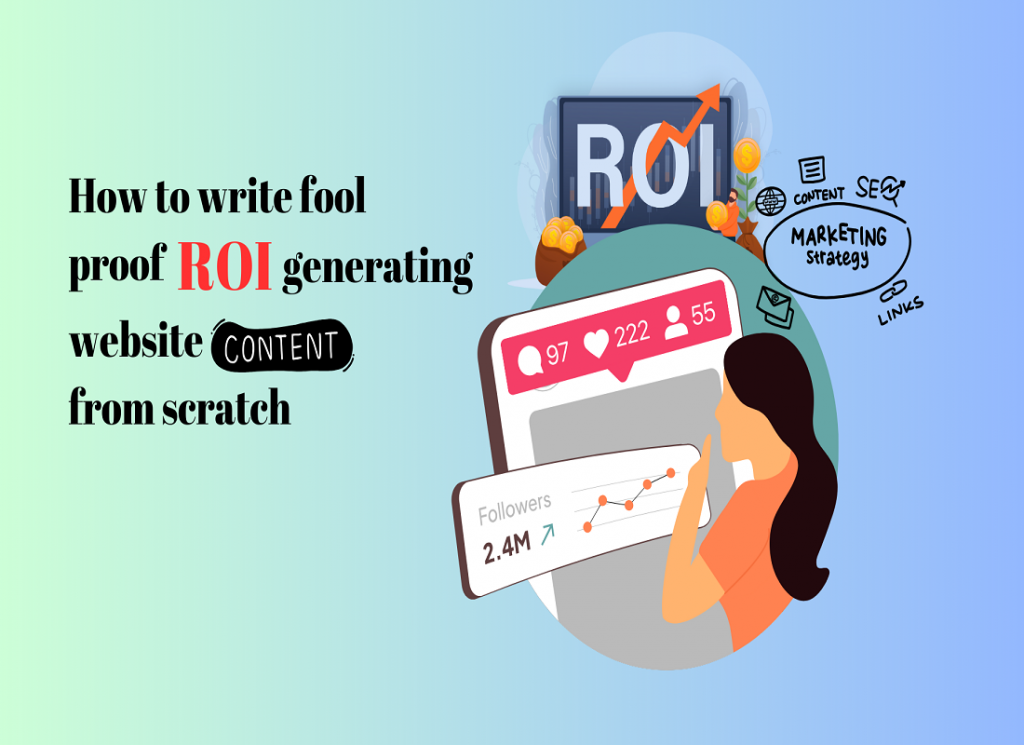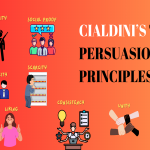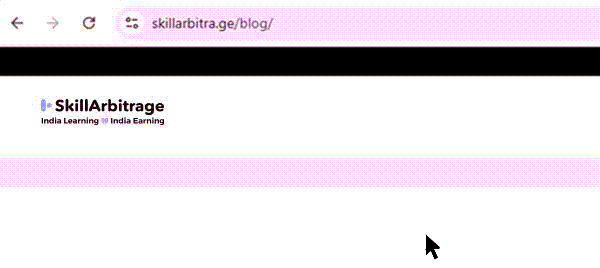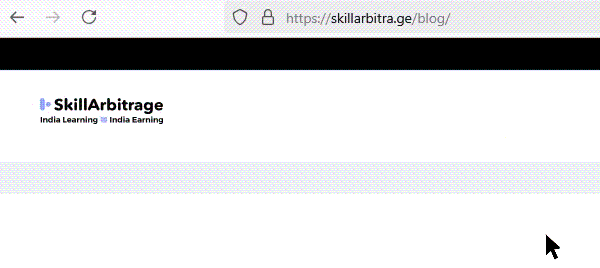Master website copywriting with this essential guide for content writers, marketers, and startup founders. Learn rules, examples, and clear frameworks that drive conversions.
Table of Contents
Introduction
Let’s begin this blog with some data.
According to a recent survey, visitors take only 50 milliseconds to form an opinion about a website. In that short time, all they can do is scan the headlines and form an initial impression.
A poorly designed website with irrelevant information can drive 38% of users away. On the other hand, a recent UK study claims that websites with high-quality copy and proper SEO rank about 53% higher in search engine results. This means more organic traffic ultimately leading to a booming revenue growth.
Clearly, no business that takes its revenue growth seriously can afford to ignore its website copy.
But first things first.
What does a website do for a business?
It builds credibility
What is the first thing anyone does when they want to check or look up something? That’s right, they Google. A good website validates the existence of a business and can increase its visibility a great deal.
It feeds multiple marketing channels
A website creates an archive of compelling and good content that can be edited into bite-sized pieces and shared across social media.
For example, you can write a good, relevant, value-enriched blog for your website and then create a podcast from it.
You can then keep sharing bits of it as reels, videos, etc. across Instagram and LinkedIn.
That’s months of social media content sorted for you.
It creates brand awareness
This one thing done right can change the Google SEO game for you. If you have enough relevant content on your website, you might get a lot of organic website traffic.
Say you own a cosmetics brand and you have a lot of content on your website about “ How to Apply Makeup”, “ Ten Trendy Lipstick Shades” etc. A lot of people who were previously not aware of your brand might discover it by chance.
Publishing around 16 blog posts per month can increase your website traffic by 3.5 times.
It is your whole time, 24/7 salesperson across the world
Websites are always active, responsible, accessible, and approachable. Anybody from anywhere can reach you through your website.
This also helps a business in tracking data to understand who are the people who are taking an active interest, in other words, who are the potential customers.
This helps in creating services to improve customer experiences.
It is a great place to tell your story
Every business has a story. A narrative that talks about how it came to be and what difference it makes to the world. A website is a great place to tell the brand’s story directly. This is an excellent way to give a human face to the brand. The more a brand becomes relatable, the more chances of it becoming a consumer favorite.
In simpler terms, the website is the brand’s human face, that is presented to the consumer. E-commerce websites serve an even more important function as business mainly occurs through them.
Website content plays an extremely important part in making a website memorable, engaging, and relatable.
Types of websites—and how copywriting differs for each
Here’s the thing about copywriting: it’s not one-size-fits-all. The copy that works brilliantly on an e-commerce site might completely flop on a corporate website. Why? Because different websites serve different purposes, and your copywriting needs to match that purpose perfectly.
Let’s break down the most common types of websites and what kind of copywriting actually works for each:
Business websites
These are your classic corporate sites that showcase what a company does, their values, and their story. Think of websites like Tata Group or Infosys—they’re not trying to sell you a product directly, but rather build trust and establish their brand presence.
The copywriting here is all about storytelling and credibility. You want copy that feels warm yet professional, highlighting the company’s expertise without sounding boastful. Focus on building emotional connections through your “About Us” page, use case studies to show real results, and create copy that positions the company as the obvious choice when prospects are ready to buy.
The key is to write like you’re having a conversation with a potential client over coffee. Share the company’s journey, explain complex services in simple terms, and always answer the reader’s biggest question: “Why should I trust you with my business?” Your copywriting should feel consultative rather than salesy.
(Source: https://www.tata.com/)
E-commerce websites
E-commerce sites like Flipkart, Amazon, or Nykaa have one primary goal: getting people to buy stuff. This means your copywriting needs to be laser-focused on conversion at every single touchpoint.
Product descriptions are your bread and butter here. Instead of just listing features, focus on benefits and emotional triggers. Don’t just say “waterproof phone case”—say “protect your phone from life’s unexpected moments.” Your copy should address objections before they arise, highlight social proof through reviews, and create urgency without being pushy.
The copywriting formula that works best is problem + solution + proof + urgency. Keep sentences short and scannable because people are browsing quickly. Use bullet points liberally, include clear calls-to-action, and remember that every word on the page should either inform the buying decision or encourage the purchase. Your checkout copy is especially crucial—remove any friction with reassuring, clear language about security and returns.
(Source: https://www.flipkart.com/)
Blog websites
Sites like The Wire, Scroll.in, or even company blogs like HubSpot’s are content powerhouses. The copywriting here serves a dual purpose: providing value to readers while subtly nurturing them toward becoming customers or subscribers.
Your copywriting needs to be SEO-friendly without sacrificing readability. This means naturally incorporating keywords, writing compelling headlines that people actually want to click, and structuring your content so it’s easy to skim. Each blog post should solve a specific problem or answer a particular question your target audience has.
The magic happens in how you weave promotional elements into educational content. Maybe you’re writing about “social media strategies” and naturally mention your social media management tool. Or you’re explaining “email marketing best practices” and link to your email templates. The copywriting should feel helpful first, promotional second. Always end with clear next steps—whether that’s subscribing to your newsletter, downloading a resource, or exploring your services.
(Source: https://blog.ipleaders.in/)
Media websites
Think Times of India, NDTV, or streaming platforms like Netflix India. These sites need copywriting that keeps people engaged, clicking, and ultimately subscribing or returning for more content.
The copywriting here is all about hooks and headlines. You need copy that makes people stop scrolling and click through. This means mastering the art of curiosity gaps (“This productivity hack changed everything”), emotional triggers (“The heartbreaking story behind India’s startup success”), and urgency (“Breaking: Major policy changes announced”).
Your subscription and paywall copy is critical. Instead of just saying “Subscribe now,” explain the value: “Get unlimited access to in-depth analysis that helps you stay ahead.” Use social proof extensively—”Join 2 million readers who trust us for unbiased news.” The copywriting should make people feel like they’re missing out on something valuable, not being pressured into buying something they don’t need.
(Source: https://timesofindia.indiatimes.com/)
Lead generation websites
These are your focused, single-purpose sites with one big, bold call-to-action. Think of landing pages for webinars, free consultations, or software demos. The entire site exists to capture contact information.
Your copywriting here needs to be incredibly persuasive in very few words. Every headline, subheading, and bullet point should reinforce the value proposition. Use the PAS formula (Problem-Agitate-Solution) to connect with visitors’ pain points, then present your offer as the obvious solution.
The magic is in the details: your headline should communicate the main benefit in under 10 words, your form copy should minimize friction (“Get instant access” vs “Fill out this form”), and your privacy copy should build trust (“We respect your inbox”). Social proof is everything—testimonials, logos of companies you’ve worked with, or specific numbers (“Join 10,000+ marketers who’ve downloaded this guide”).
(Source: https://www.flowersofcharlotte.com)
Other website types worth mentioning
Portfolio websites (like those of photographers or designers) need copywriting that lets the work speak first but provides context and personality. Non-profit websites require emotional storytelling that connects donors to the cause. Event websites need urgency-driven copy that handles logistics while building excitement.
The bottom line on copywriting for different websites
Here’s what every website content writer needs to understand: your copywriting strategy should match your website’s primary goal, not your personal writing style. A fashion e-commerce site needs different copy than a B2B consulting firm, even if they’re both trying to make money. The best copywriting feels natural to the context—it serves the user’s needs while advancing the business objective. Master this principle, and you’ll write copy that actually works, regardless of what type of website you’re working on.
Two deadly effective storytelling techniques for website content
If you are selling a solution through your website or your objective is to generate revenue without directly selling products, here are the two best formats you can use.
In order to show you how these two frameworks work, I would take the help of a hypothetical brand. Let’s assume I am writing copy for a website which offers SEO optimized web copy solutions to businesses.
PAS – Problem Agitate Solution
Here’s an example.
Problem: How the problem affects you
It must be so difficult running a full-blown business, taking care of products, catering to customer demands, and finding out more ways to generate business every day.
Agitate: Appeal to emotions
We can imagine the frustration you must feel with your website. It is supposed to generate leads automatically after all the money and time you have spent on it, but right now it is little more than just a domain name.
Solve: Introduce the brand as the solution
This is where we (name of the content solution providing brand) come in. We create SEO optimized content that generates 3x leads for your business.
Book a free call with us today for a website copy audit.
Use the AIDA framework
Alternatively, you could use the Attention-Interest-Desire-Action (AIDA) framework to write your website copy instead of the PAS formula. This approach breaks down the content into four key elements:
Attention
Grab the reader’s attention with a bold headline or compelling statement that addresses their pain point.
Example: Did you know effective website copy can give you 54% more leads than traditional marketing methods?
Interest: Explain how your solution can solve their problem and capture their interest.
Example: Our website copy solutions have helped xx businesses in yy countries garner 3x more leads within the first 30 days!
Desire: Create desire by demonstrating the benefits of using your product or service.
Example: Do you want to try it for yourself and see how easy it can be to generate business via your website by changing only the copy?
Action: Finally, include a clear call-to-action (CTA) that encourages the reader to take the next step
Example: Book a free consultation with our copy experts today.
4-step website copywriting process for maximum conversions
Creating effective website copy isn’t about throwing words at a page and hoping something sticks. It’s a strategic process that turns visitors into customers by speaking directly to their needs, desires, and pain points. Here’s the proven 4-step framework that professional copywriters use to create high-converting websites.
Step 1: Define your website’s purpose and type
Before you write a single word, you need crystal clarity on what your website is supposed to accomplish. This isn’t just about saying “I want to make money”—it’s about understanding exactly how your website fits into your customer’s journey and what specific action you want them to take.
Different website types require completely different copywriting approaches. An e-commerce site selling fashion accessories needs urgent, benefit-driven copy that addresses objections quickly. A B2B consulting firm needs trust-building copy that demonstrates expertise and credibility over time. A SaaS landing page needs clear, feature-focused copy that explains complex solutions simply.
Start by asking yourself these questions: Are you trying to generate leads, sell products directly, build brand awareness, or educate your audience? Is your sales cycle short (like impulse purchases) or long (like enterprise software)? Do people buy from you emotionally or after careful research and comparison?
Your answers will determine everything from your headline strategy to your call-to-action placement. For example, if you’re selling emergency plumbing services, your copy needs to create urgency and highlight immediate availability. If you’re selling financial planning services, your copy needs to build trust and demonstrate long-term value.
Write down your primary goal, secondary goals, and the specific action you want visitors to take. This becomes your north star for every word choice, every headline, and every page structure decision you make.
Step 2: Create detailed consumer personas through strategic research
Understanding who you’re writing for isn’t optional—it’s the foundation of copywriting that actually converts. A consumer persona is your detailed, research-backed profile of your ideal customer, including their demographics, motivations, pain points, and decision-making process.
How to research your consumer personas effectively:
1. Start with existing customer data Analyze your current customers through surveys, interviews, and sales data. Look for patterns in demographics, buying behavior, and feedback. Your best customers often share similar characteristics that you can replicate in your messaging.
2. Conduct social media research Monitor your industry’s social media conversations, comments on competitor posts, and relevant Facebook groups or LinkedIn communities. Pay attention to the language people use to describe their problems and the solutions they’re seeking. Tools like Brandwatch or simply searching hashtags can reveal valuable insights.
3. Use survey tools strategically Create targeted surveys using platforms like SurveyMonkey or Google Forms. Ask about their biggest challenges, what they’ve tried before, what almost stopped them from buying, and what finally convinced them. Focus on emotional triggers, not just logical factors.
4. Analyze customer support tickets and reviews Your support team interactions and online reviews contain goldmines of customer language. Look for recurring complaints, praise patterns, and the exact words customers use to describe your product’s impact on their lives.
5. Interview customers directly Schedule 15-20 minute calls with recent customers. Ask open-ended questions about their journey from problem awareness to purchase decision. Record these calls (with permission) to capture exact phrases and emotional reactions.
Essential persona elements to include:
- Demographics: Age, location, job title, income level, education
- Psychographics: Values, interests, lifestyle preferences, fears
- Pain points: Specific problems they face and how these problems affect their daily life or business
- Goals and motivations: What they’re trying to achieve and why it matters to them
- Information consumption habits: Where they get information, preferred content formats, trusted sources
- Buying behavior: How they research purchases, what influences their decisions, typical objections
- Communication preferences: Formal vs. casual tone, technical vs. simple language, preferred channels
The key is making your personas feel like real people, not abstract demographic data. Give them names, faces, and specific scenarios. “Marketing Manager Maria” who struggles with proving ROI to her CEO is much more actionable than “B2B decision-maker, 35-45, $75K+ income.”
Step 3: Choose and implement a proven storytelling framework for your main pages
Great copywriting follows proven psychological frameworks that guide readers from curiosity to action. Instead of randomly arranging information, use a storytelling framework that creates emotional engagement while addressing logical concerns.
Popular frameworks that work in 2025:
Problem-Agitate-Solution (PAS) Start by identifying a problem your audience faces, agitate the pain by showing consequences of not solving it, then present your solution as the obvious choice. This works particularly well for service-based businesses and products that solve clear pain points.
Example structure: “Struggling with inconsistent sales? (Problem) Every month of unpredictable revenue puts your business stability at risk, making it impossible to plan for growth or feel confident about the future. (Agitate) Our sales automation system gives you predictable, scalable revenue by converting 40% more leads into paying customers. (Solution)”
Before-After-Bridge (BAB) Show the current frustrating situation, paint a picture of the ideal outcome, then position your product as the bridge between the two. This framework works excellently for transformation-focused products and services.
StoryBrand Framework Position your customer as the hero of their own story, with your company as the guide who helps them overcome challenges and achieve their goals. This framework builds trust and emotional connection while keeping the customer at the center of the narrative.
AIDA (Attention-Interest-Desire-Action) Grab attention with a compelling headline, build interest with benefits and social proof, create desire through emotional triggers and urgency, then drive action with clear calls-to-action.
Implementation strategy:
Choose one primary framework for your homepage and main landing pages. Your homepage might use StoryBrand to build trust and explain your value proposition, while your product pages use PAS to address specific pain points and drive purchases.
Ensure your framework choice matches your audience’s awareness level. If they don’t know they have a problem, start with education. If they’re comparing solutions, focus on differentiation and proof. If they’re ready to buy, emphasize urgency and social proof.
Your framework should flow naturally through your page sections: headline, subheadline, value proposition, benefits, social proof, objection handling, and call-to-action. Each section should advance the story while addressing logical and emotional needs.
Step 4: Create cohesive, conversion-focused copy across all supporting pages
Your website is an ecosystem where every page should support your main conversion goals while serving its specific purpose. This means creating copy synergy where the tone, messaging, and value proposition remain consistent while each page addresses different stages of the customer journey.
Essential pages and their copywriting focus:
About page: Build trust and credibility by telling your origin story, highlighting your team’s expertise, and showing personality. Focus on why you started the business and how you uniquely help customers achieve their goals.
Service/product pages: Dive deep into specific benefits, address common objections, and provide detailed information that supports purchase decisions. Use the same core messaging framework but tailor content to each offering’s unique value.
Contact page: Remove friction by explaining your process, setting clear expectations for response times, and providing multiple contact options. Include trust signals like certifications, testimonials, or security badges.
FAQ page: Address every possible objection, concern, or question that might prevent someone from converting. Use the exact language your customers use when asking these questions.
Blog/resource pages: Provide value while subtly demonstrating your expertise and guiding readers toward your main conversion pages. Each piece should solve a real problem while positioning your paid offerings as the next logical step.
Maintaining copy synergy:
Use consistent language and terminology across all pages. If you call something “marketing automation” on your homepage, don’t call it “automated marketing tools” on your service page. Create a messaging document that defines key terms, value propositions, and brand voice guidelines.
Ensure smooth transitions between pages by using internal linking and consistent calls-to-action. Someone reading your blog should naturally flow to relevant service pages, and someone on a service page should easily find case studies or testimonials that support their decision.
Test different approaches and continuously optimize based on user behavior data. Use tools like Google Analytics to see which pages have high bounce rates or where people exit your site, then refine your copy to better meet visitor needs at those points.
Remember that every word on your website should either provide value to the visitor or move them closer to your conversion goal. Eliminate corporate jargon, unnecessary words, and confusing navigation. Your copy should feel like a helpful conversation with someone who understands their problems and has the perfect solution.
What is the best content model for website copywriting?
The inverted pyramid
People have a minuscule attention span these days—you have less than 8 seconds to capture someone’s interest before they click away. That’s why the inverted pyramid model works so effectively for your website copywriting. Keep the most important information about your business right at the top of every page, starting with your strongest value proposition and primary benefit.
Your headline and first paragraph should immediately answer your visitor’s most pressing question: “What’s in it for me?” Lead with your biggest promise, strongest benefit, or most compelling offer. This could be a specific result you deliver, a unique advantage you provide, or a clear solution to their main problem.
As your visitors scroll down, they should receive progressively more detailed information while encountering more visuals, testimonials, and supporting evidence. The middle section can include your secondary benefits, feature explanations, and social proof. The bottom of your page is where you place detailed specifications, fine print, or comprehensive FAQ sections—information that’s important for decision-making but not essential for initial engagement.
This structure works because it matches natural reading behavior online. Most visitors scan rather than read, and they make quick decisions about whether to stay or leave based on what they see first. By front-loading your most compelling information, you hook their interest immediately and earn the right to their continued attention as they scroll deeper into your content.
A design to copy the approximate ratio is also shown in this next diagram.
( Source: https://www.jimdo.com/blog/11-golden-rules-of-writing-website-content/)
What are the rules we need to follow to write effective website content?
Length and Formatting
Keep copy short and concise and do not write sentences that are longer than 30 – 35 words. This enhances readability. Remember, that a lot of people would be accessing your website from their mobiles as well.
74% of people are more likely to return to a site that is mobile-friendly. (WebFX)
Keep spaces between paragraphs and do not make any paragraph more than three to four sentences long at max. This will help your reader/user/consumer read it more easily.
Use bullets whenever you need to give out a bunch of technical information.
Language
Avoid lengthy and uncommon words. Depending on whether you are building brand image or directly selling from your website, the tone can range anywhere from professional to downright quirky.
But, the thumb rule remains that the content must be understood by all.
( Source: https://www.upwork.com/)
Notice the bullets and the vocabulary in this example.
Nothing complex or difficult about it, is there?
This is how website copy needs to be written.
Voice
Stick to active voice. This makes the copy dynamic, energetic, and action-oriented.
Jargon
Avoid jargon and insider words. Usage of insider terms alienates the readers. For example, where you are itching to write “state-of-the-art”, write “advanced” instead.
Uniformity
Use the same word for the same thing throughout the copy. If you are an automobile dealer, don’t call the vehicles automobile in one section and cars in the next.
How to measure the effectiveness of your website copy?
Here are some key metrics to measure the effectiveness of your website copy.
Total visits
How many people are visiting your website per day/ in a specific time period? It is vital to know this to know the effectiveness of your website content.
Unique visits
This is similar to website visits, but if Mr. X visits your website five times, it will calculate it as one visit and help you track which sections Mr. X is visiting more frequently than the others.
Page views
Which of the pages is generating the most traffic to your website? If you know this, you can optimize the rest of your website copy by keeping that page as a model.
Conversion rate
Is the user taking any action after the visit? Is s/he mentioning you on social media, buying from you, filling up a form on your website? If the conversion rate is low then your copy is failing to reach the mark.
Session duration
How much time are they spending on your website? If the copy is effective, then the visitor would be spending a long time on your website.
Google ranking
Is your website ranking on the first page of Google? The best websites rank in the first 3 of Google ranking. If not you need to reanalyze the whole content and the SEO also.
Now you not only know how to write effective website copy but how to measure the effectiveness as well! can write an effective website as simply as saying ABC!
Did you find it helpful?
Drop me a line to know if it did!
FAQ
1. What is the first thing you need to know in order to write a website?
The purpose determines the tone and entire layout of the website. The whole copy will be dependent on whether you are selling from your website or only creating a digital presence.
2. How is device compatibility important in making a website?
More than 60% of consumers use mobile devices to read content on the web. The website content must be readable on any device.
3. How to enhance the readability of website copy?
Use white spaces and avoid long and complicated sentences. Use bullets whenever you can.
4. How does SEO help in boosting website traffic?
SEO boosts website traffic by improving search rankings, making your site more visible to users searching for relevant keywords. It enhances user experience, credibility, and organic reach, driving consistent and high-quality traffic.
5. What’s the difference between copywriting and content writing on websites?
Copywriting is about prompting action—persuasive, concise, and conversion-focused. Content writing informs and educates in a friendly tone, often longer and SEO-driven. On a website, copy drives clicks and conversions (e.g., on homepages or product pages), while content like blogs builds trust and authority over time.
6. Why is the headline so important in website copywriting?
The headline is your first—and sometimes only—chance to grab attention. In website copywriting, a strong headline clarifies your value, sets user expectations, and encourages visitors to keep reading instead of bouncing away.
7. How do I tailor website copy to different pages (home, about, services)?
Each page serves a unique purpose—home pages introduce, about pages build brand personality, services highlight benefits, and blog pages educate. Use tone, length, and structure strategically: action-driven for home and services, narrative for about, and value-rich for blogs.
8. What role does SEO play in effective website copywriting?
SEO and copywriting go hand-in-hand. Optimized copy (with targeted keywords, meta tags, and internal links) improves search visibility while still connecting emotionally with readers—so your site both ranks well and engages meaningfully.
9. How do you test if website copywriting is working?
Track metrics like time on page, click-through rates, bounce rates, and conversions (e.g., form fills or purchases). A/B test headlines, CTAs, and copy length to see what resonates. Tools like Google Analytics and heatmaps help measure performance and inform optimization.







 Allow notifications
Allow notifications
